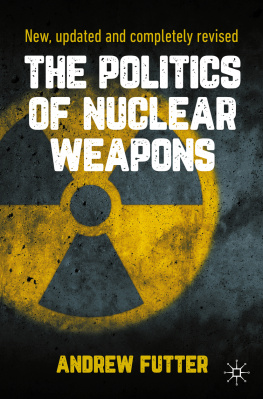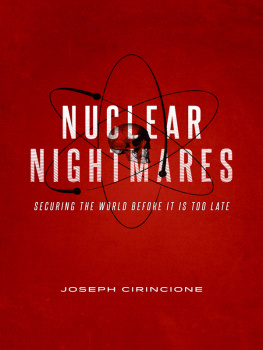Whitehall Paper 78
Less is Better
Nuclear Restraint at Low Numbers
Malcolm Chalmers
www.rusi.org
Royal United Services Institute for Defence and Security Studies
Less is Better: Nuclear Restraint at Low Numbers
By Malcolm Chalmers
First published 2012
Whitehall Papers series
Series Editor: Professor Malcolm Chalmers
Editors: Adrian Johnson and Ashlee Godwin
RUSI is a Registered Charity (No. 210639)
ISBN 978-0-415-81422-5
Published on behalf of the Royal United Services Institute for Defence and Security Studies
by
Routledge Journals, an imprint of Taylor & Francis, 4 Park Square, Milton Park, Abingdon OX14 4RN
SUBSCRIPTIONS
Please send subscription orders to:
USA/Canada: Taylor & Francis Inc., Journals Department, 325 Chestnut Street, 8th Floor, Philadelphia, PA 19106, USA
UK/Rest of World: Routledge Journals, T&F Customer Services, T&F Informa UK Ltd, Sheepen Place, Colchester, Essex CO3 3LP, UK
All rights reserved. No part of this publication may be reprinted or reproduced or utilised in any form or by any electronic, mechanical, or other means, now known or hereafter invented, including photocopying and recording, or in any information storage or retrieval system, without permission in writing from the publisher.
Contents
Professor Malcolm Chalmers is director of research at the Royal United Services Institute, London, and leads its work on nuclear policy issues. He is a special adviser to the UK Parliaments Joint Committee on the National Security Strategy, and has been a visiting professor of defence and foreign policy in the Department of War Studies, Kings College, London, and a special adviser to Foreign Secretaries Jack Straw MP and Margaret Beckett MP. Professor Chalmers has also been professor of international politics at the University of Bradford; visiting fellow at the Center for International Security and Arms Control, Stanford University; and senior consulting fellow, International Institute for Strategic Studies.
His recent publications include: 'Kingdom's End?', RUSI Journal (Vol. 157, No. 3, June/July 2012); 'Looking Beyond the Chicago Summit: Nuclear Weapons in Europe and the Future of NATO' (a joint Carnegie/Brookings/RUSI paper, written with George Perkovich, Steven Pifer, Paul Schulte and Jaclyn Tandler, April 2012); 'Arms Control after START', in Nichols, Stuart and McCausland (eds.), Tactical Nuclear Weapons and NATO (Carlisle, PA: US Army War College, April 2012); 'The End of an "Auld Sang": Defence in an Independent Scotland', RUSI Briefing Paper, April 2012; 'Forging UK-China Consensus on a Strengthened NPT Regime', RUSI Occasional Paper, March 2012; 'Small Nuclear Forces: Five Perspectives', RUSI Whitehall Report, 3-11, December 2011; 'Words That Matter? NATO Declaratory Policy and the DDPR', in Andreasen and Williams (eds.), 'Reducing Nuclear Risks in Europe', NTI, 2011; 'Nuclear Weapons and the Prevention of Major War' in Bruno Tertrais (coordinator), Thinking About Strategy: A Tribute to Michael Quinlan (Paris: Fondation pour la Recherche Stratgique, 2011); 'Looking into the Black Hole: Is the UK Defence Budget Crisis Really Over?', RUSI Briefing Paper, October 2011; 'Comparing UK and Chinese Nuclear Force Development', Peace and Development (Beijing) (June 2011); 'If the Bombs Go: European Perspectives on NATO's Nuclear Debate', RUSI Whitehall Report, 1-11, May 2011; 'Continuous At-Sea Deterrence: Costs and Alternatives', RUSI Briefing Note, July 2010; 'Nuclear Narratives: Reflections on Declaratory Policy', RUSI Whitehall Report, 1-10, May 2010; 'NATO's Tactical Nuclear Dilemma', RUSI Occasional Paper, March 2010 (with Simon Lunn); and 'Britain's New Nuclear Debate', RUSI Journal (Vol. 154, No. 2, April 2009).
As I have developed this paper, I have been fortunate to have been able to present some of the ideas that it contains at seminars and conferences around the world, and to listen to perspectives from experts hailing from all of the worlds nuclear-armed states. Paul Schulte has been a frequent companion at many of these events, and I learnt much from our frequent discussions and jointly written projects, as well as from his persuasive comments on this paper in draft form. Shashank Joshi, my RUSI colleague, took time away from writing his own monograph on Irans nuclear programme to provide detailed feedback. I owe a particular and heartfelt debt to James Acton for his thoughtful, detailed and incisive comments on an earlier draft. James has already written several excellent papers on deterrence at low numbers, all of which provided inspiration for this work.
I would particularly like to thank Ashlee Godwin and Adrian Johnson for their tireless editorial efforts. The paper would have been much poorer without their insistence on clarity and conciseness.
This paper was made possible as a result of the financial support of the Nuclear Threat Initiative in Washington, DC, which has consistently supported RUSIs nuclear work for several years.
- ABM Anti-ballistic missile
- BMD Ballistic missile defence
- CBW Chemical and biological weapons
- CTBT Comprehensive Test Ban Treaty
- DDPR Deterrence and Defence Posture Review
- DRDO Defence and Research Development Organisation (India)
- EPAA European Phased Adaptive Approach
- FMCT Fissile Material Cut-Off Treaty
- GDP Gross domestic product
- ICBM Intercontinental ballistic missile
- INF Intermediate-range nuclear forces
- MIRV Multiple independently targetable re-entry vehicle
- MTCR Missile Technology Control Regime
- NAS National Academy of Sciences (US)
- NATO North Atlantic Treaty Organization
- NPT Nuclear Non-Proliferation Treaty
- NSNW Non-strategic nuclear weapons
- OECD Organisation for Economic Co-operation and Development
- SALT Strategic Arms Limitation Talks
- SLBM Submarine-launched ballistic missile
- SSBN Ballistic missile submarine
- SSOD Special Session on Disarmament
- START Strategic Arms Reduction Treaty
- UK United Kingdom
- UN United Nations
- US United States of America
The number of nuclear weapons in the worlds arsenals has been reduced by around 80 per cent over the last two decades. Yet, as the USs 2010 Nuclear Posture Review made clear: both [the US and Russia] still retain many more nuclear weapons than they need for deterrence.'
The purpose of this paper is to examine how, and under what conditions, further cuts in these stockpiles could be made. It argues that steep reductions are possible if all seven established nuclear-armed states accept as an objective nuclear restraint at low numbers, defined as a situation in which each country feels comfortable with a stockpile numbering less than 500. If this objective were accepted, it would make possible a further 80 per cent reduction in the global military stockpile: from 11,500 warheads in 2012 to around 2,000 in the early 2020s. The main responsibility for achieving this objective would fall on Russia and the US, which still possess more than 90 per cent of the worlds nuclear stockpile; but the five other states (China, France, the UK, India and Pakistan) would also have to take steps to restrain the size and capabilities of their own forces, and to show that they are doing so.














